Rozne odcienie mate / Different shades of yerba mate


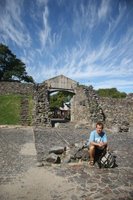



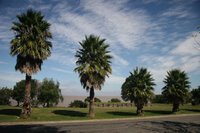





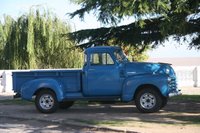


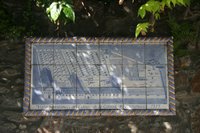

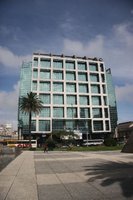
















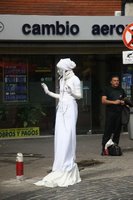











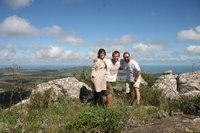
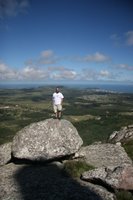

























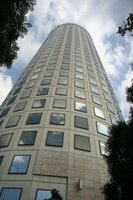



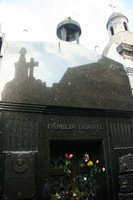






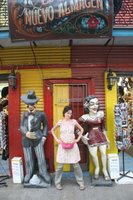
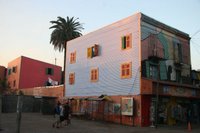











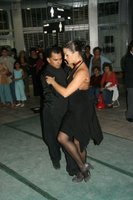


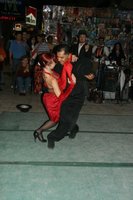


 Obiecanki, cacanki... :)))
Obiecanki, cacanki... :)))Rano w piatek wstalismy i ruszylismy zaspani na podboj Urugwaju. Po milej pogawedce z kierowca autobusu (“Po ile wasza zlotowka? Dokladnie tyle co peso? Uj to slabo, kryzys u was…U nas kiedys jeden peso to byl jeden dolar, a teraz...”) przesiedlismy sie do ogromnego promu zwanego Buquebus. Po zatloczonej, acz skutecznej odprawie paszportowej, rozparci na wygodnych promowych fotelach zapadlismy w blogi sen, dzielnie ignorujac pokladowe przekaski oferowane za bajonskie sumy. Ani sie obejrzelismy, jak wyladowalismy w “kolonialnej perle Urugwaju”, czyli Colonia del Sacramento. Miasto, a wlasciwie miasteczko ma ciekawa historie – zalozyli je Portugalczycy aby przemycac towary do prowincji Buenos Aires, w odpowiedzi Hiszpanie zalozyli w tym samym celu Montevideo, dzis stolice Urugwaju, a nastepnie odbili sila Colonie. Potem miasto przechodzilo z Hiszpanii do Portugalii i wice wersa az siedem razy (w wyniku bitew lub traktatow). Sama starowka, choc mocno reklamowana, jest raczej slabawa. Male parterowe domki ciesza oko przez godzine, dwie, a potem sie nudza. Atmosfery nie poprawial fakt, ze rzeka La Plata, nad ktora lezy miasto (i pol Urugwaju) miala akurat mimo slonecznego na szczescie dnia brudny mulisty kolor, wiec na plazy widokiy tez byly takie sobie. Ciekawostka jest za to fakt, ze La Plata w tym miejscu uchodzi do Atlantyku, a szerokosc jej ujscia to w porywach do kilkudziesieciu km (swiatowy rekord), wiec trudno juz powiedziec, czy to jeszcze rzeka czy juz ocean. W kazdym razie jesli kryterium jest widocznosc drugiego brzegu, to La Plata w tym miejscu rzeka z pewnoscia juz nie jest (vide zdjecia).
Po krotkim zwiedzaniu (w miescie jest az siedem muzeow!, wielkosci mniej wiecej kawalerki na Ursynowie kazde, mozna na nie kupic zbiorczy bilet, ale bilety sprzedaja tylko w JEDNYM z nich, wiec sobie odpuscilismy), wizycie w jedynym, nieciekawym kosciele i jedynej, zrujnowanej kapliczce, stwierdzilismy, ze nawet pamiatek nie maja tu porzadnych (tym lepiej, mniej sie wyda... hehe) i zebralismy sie do odjazdu. Rozumiemy, ze Colonia jest weekendowym celem wypraw mieszkanow Buenos (porteños), bo jest spokojna, urocza i lezy blisko granicy, ale do nas jakos nie trafila...Jeszcze telefon do Buenos do fotoserwisu (zostawilem tam dzien wczesniej szwankujacy teleobiektyw, na dzis miala byc wycena naprawy), oczywiscie nikt nic nie wie, wiec ze zloscia sie rozlaczam i fruniemy na dworzec..
Autobus do Montevideo jechal zgodnie z rozkladem. Za oknem podziwialismy kompletnie plaskie krajobrazy, glownie bezlesne rowniny (ponoc ogromne lasy bezlitosnie wycieli Argentynczycy 400 lat temu, kolejny powod do sasiedzkiej niecheci : ). W Montevideo na zaskakujaco zatloczonym dworcu odebral nas nasz gospodarz, Gonzalo. Dobrze, ze nas poznal, bo my jego zdjecia nie widzielismy. Powital nas serdecznie i zabral do siebie na chwile odpoczynku przed wieczornym wyjsciem.
Gonzalo mieszka we wlasnej kamienicy w starej czesci Montevideo. Dom nie jest wielki, ma 1 pietro i strych, ale prezentuje sie okazale, a wystroj i wykonczenie wnetrza (oryginalne,z poczatku wieku) przywodzi na mysl kancelarie wypasionych gdanskich lub warszawskich notariuszy lub adwokatow – pierwsza klasa. Rzucamy sie w wir zycia nocnego.
Montevideo jest jedna z najmniejszych stolic kontynentu (ledwie 1,3 mln ludzi), ale takze miastem zaskakujaco energicznym. Najpierw idziemy skosztowac tradycyjnych kanapek chivitos (“koziolki”), wypelnionych wolowina, jajkiem i warzywami, ktore okazuja sie wysmienite, a potem przenosimy sie do pubu. Gonzalo opowiada nam o swoich podrozach. Po angielsku mowi prawie jak jankes. Spedzil ponoc 6 lat na studiach w USA, a liste krajow, ktorych nie odwiedzil moglbym pewnie z latwoscia przytoczyc, choc musialbym to sprawdzic. Jednym z nich jest Polska, wiec mam nadzieje, ze w tym roku G. nadrobi braki. Ludzie tutaj w ogole sporo podrozuja, Np. studenci architektury po studiach jada na 9 miesieczna podroz po calym swiecie odwiedzajac naslynniejsze dokonania swiatowego budownictwa. Podroz finansuja sami sprzedajac specjalne losy na loterie. Doskonaly system!
Mimo, ze siedzimy do poznych godzin, o 4.00 nad ranem starowka wciaz suna bezustannie we wszystkich kierunkach tlumy mlodych ludzi (tak! tlumy!) Tego nie widzialem nawet w Krakowie w sezonie, a tu przeciez idzie jesien i robi sie chlodnawo. Spory wigor ma to miasto, tak trzymac!
My z troche mniejszym wigorem wstajemy nastepnego dnia na lekkim kacu. i w towarzystwie naszego gospodarza udajemy sie na zwiedzanie Montevideo. Gonzalo opowiada mnostwo ciekawych rzeczy o swojej stolicy, mamy wiec duze szczescie, ze nie musimy zwiedzac miasta sami. Miasto jest czyms w rodzaju Buenos Aires w duzym pomniejszeniu, ale sprawia tez wrazenie bardziej zorganizowanego. Fenomenem jest to, ze nikt tutaj nigdzie sie nie spieszy. Bieganie do autobusu jest w zlym guscie. Mimo, ze widac, iz niektorzy ida w garniturach do pracy, suna statecznie po chodniku ze zrelaksowanym spojrzeniem, trzymajac w rece nieodlaczne kubeczki z mate, a niektorzy rowniez termosy pod pacha (posikac sie mozna ze smiechu!!) Zabudowa miejscami bardzo nowoczesna, miejscami jest mocno nobliwa, a XIX wieczne eklektyczne kamienice przypominaja bardzo najswietniejsze przyklady architektury w... Lodzi (toutes proportions gardees.. : ) Oczywiscie i tu jest plaza oraz wszechobecna La Plata, a takze sympatyczny nadmorski deptak – Rambla. Gonzalo pokazuje nam z zapalem wszystkie zakatki miasta, lacznie z wwiezieniem nas na gorujaca nad miastem Cerro Montevideo, skad roztacza sie ciekawa panorama na cala zatoke. Kolejna ciekawa cecha Montevideo jest to, ze mimo iz argentynski kryzys z 2001 r. odbil sie mocno na Urugwaju, prawie nie widac tu ludzi biednych, czy zebrakow. W ogole ten kraj wyglada, jakby lezal na innym kontynencie - w Europie. Z kilku powodow. Pierwszym jest zabudowa, drugim ludzie. Praktycznie wszyscy sa tu biali (potomkowie Wlochow i Hiszpanow), murzyna spotkalismy jednego (niewolnictwo tu nie dotarlo), a Indian zadnych (poniewaz lokalni Charua stawiali zbyt mocny opor najezdzcom, zostali w XIX w doslownie do nogi wybici, a ze przedtem zaden z nich nie mieszal sie z przybyszami, teraz nic po nich nie zostalo). Jesli doda sie do tego klimat (normalne pory roku z zima, jak u nas, choc bez sniegu), brak zwyczaju targowania sie, brak krzykliwosci handlarzy na ulicach i np. zakaz palenia praktycznie wszedzie poza wlasnym domem (od 1 marca! SUPER! – Argentynczycy niestety kopca mocniej niz lokomotywa Tuwima), to trudno uwierzyc, ze jestesmy w Ameryce Poludniowej (i to mocno poludniowej : ) A.. jeszcze podobno brak korupcji, brak cinkciarzy na ulicach (fakt!) i poszanowanie dla prawa zgola niespotykane w innych krajach kontynetu. Tak duze, ze w paru centralnych miejscach miasta widoki szpeca niedokonczone biurowce – wlasciciel nie ma czasu, zeby skonczyc, a procedury sadowe ciagna sie w nieskonczonosc. Nikt nie chce pochopnie rozbierac, bo przeciez czyjs interes moglby ucierpiec. Sprawe trzeba zbadac na spokojnie... I tak badaja od 9 lat... (patrz fotka)
Po solidnym zwiedzaniu idziemy na posilek i tu pierwsze rozczarowanie. Urugwaj kulinarnie jest sporo drozszy od Argentyny, a podanej mi wolowiny nie umiem zmoc nawet ostrym nozem. O cenach wina nie wspominam. Coz, jestesmy tu tylko kilka dni...Chcemy jeszcze isc na mecz (Gonzalo ma jakis karnet VIP), bo choc Urugwaj obecnie nie jest mistrzem swiata, ale jednak dwa razy Mundial wygral, tylko ze okazuje sie, ze wpuszczaja tylko w dlugich spodniach i butach, wiec odchodzimy jak niepyszni (kiedy w koncu obejrzymy tu jakis mecz..! : )
Nastepnego dnia rano wstajemy i jedziemy z Gonzalem do trzeciej najbardziej znanej atrakcji turystycznej Urugwaju – Punta del Este, luksusowego kurortu plazowego, polozonego juz nad otwartym morzem. Najpierw jednak przejezdzamy przez Piriapolis i robimy sobie zdjecie przy hotelu Argentino, w ktorym nocowali bohaterowie filmu Whisky, najobficiej nagrodzonego osiagniecia kinematografii urugwajskiej. Hotel jest ladny tak czy inaczej, a plaza wyglada na opuszczona. Podobno to nie sezon, choc jest wciaz dosc cieplo. Nastepnie ruszamy dalej na wschod i jakby z marszu zdobywamy 300-metrowe wzgorze Pan de Azucar, trzecie najwyzsze w kraju, z ktorego rowniez widoczki sa w miare ciekawe (a zwlaszcza z wielkiego krzyza na jego szczycie, na ktory mozna wejsc po schodach w srodku). Zejscie nie jest juz tak latwe, bo robi sie slisko, ale trudy na dole osladzaja nam nandu i kapibary zgromadzone w lokalnym minizoo. Poniewaz godzina juz popoludniowa, ruszamy do Punta del Este, zwiedzajac po drodze Casapueblo, fantazyjna rezydencje najslynniejszego lokalnego artysty, Carlosa Paez Vilaro. Film “o jego zyciu” uswiadamia nam, ze facet jest kabotynem i snobem, ale przy okazji ma niezly gust do architektury, choc architektem nie jest, oraz swietna glowe do interesu (zajrzyjcie do sklepu z pamiatkami, bedziecie wiedziec, o czym mowie). Zeby sfotografowac cala rezydencje z plazy, trzeba zjechac winda 10 pieter i zamowic u naburmuszonego kelnera superdroga herbate (na wszystko inne skapimy), ale warto (tak tak, rezydencja jest ogromna, jest tam muzeum, hotel, baseny, kawiarnia, sklep z pamiatkami i oczywiscie czesc mieszkalna dla artysty, a najlepsze jest to, ze wciaz ja rozbudowuja). Przy wyjsciu zaprzyjazniam sie z kotem mistrza lub jakiegos miejscowego notabla (piekny kawowy syjam o blekitnych oczetach, takie raczej nie walesaja sie bezpansko), wiec troche zal mi odjezdzac, ale moze sklonujemy sobie takiego po powrocie... : )
Potem jeszcze szybki objazd po Punta del Este (faktycznie, nic tu nie ma), fotografia ze slynna rzezba La Mano (palce zagrzebane w piachu na plazy) i wracamy do Montevideo. Na kolacje, zgodnie z obietnica dana gospodarzowi, tradycyjne polskie placki z jablkami. Jablka wygladaja swietnie, jak w Europie, pierwszy raz takie widzimy. Cieszymy sie do czasu, kiedy okazuje sie, ze maja smak malin. Zdaje sie, ze zrobilismy placki z... pigwa.. Nie uwierzycie, ale byly naprawde niezle. A najwazniejsze, ze naszemu gospodarzowi smakowaly.
Podczas pogawedki dowiedzielismy sie jeszcze, ze niezbyt lubiani sa tu Argentynczycy, bo sa halasliwi, niegrzeczni i obcesowi jako turysci, a zaborczy i zarozumiali jako sasiedzi. Podobno jak tylko ktos z Urugwaju sie tam wybije (po kariere trzeba stad jechac do “wielkiego miasta” czyli do Buenos), Argentynczycy anektuja go jako “swojego”. A wiec tu info: Carlos Gardel (tworca Tanga) oraz Natalia Oreiro : ) to Urugwajczycy!!! Zapamietali? No!
W miescie trwa akurat festiwal gaucho. Gaucho to lokalni kowboje, pracownicy hodowcow bydla. Na handlu bydla wzrosl Urugwaj, a sprzedaz miesa nadal stanowi najwazniejsza czesc eksportu, wiec trudno sie dziwic, ze tradycja gaucho jest bardzo mocna (polowa souvenirow to noze, lassa czy popregi gaucho). Festiwal ma to do siebie, ze odbywaja sie na nim pojedynki gaucho znane z 8 mili Eminema. Otoz jeden gaucho wychodzi na scene z gitara i cos spiewnie improwizuje, a drugi ma mu potem odpowiedziec na temat. Potem pierwszy znow odpowiada i tak trwa pojedynek. Zaluje, ze sie nie zalapalismy...
Nastepnego dnia Gonzalo leci do pracy, a my na ostatnie kilka godzin do miasta. Kupujemy jeszcze lokalny pojemniczek na mate na targu i czas jakos tak szybko mija. W autobusie na dworzec humor psuje nam falszujacy chlopaczek dracy jape ile wlezie a nastepnie zbierajacy chyba na piwo. Ale to jedyne zaklocenie harmonii istnienia w tym niebiansko spokojnym miescie. Wyjezdzamy stad z zalem, nie spotkawszy Kobylanskiego, konsumujac ostatnie chivitos na dworcu i wysylajac pocztowki (bo tu wysylka 3 zl, w Argentynie – 15 zl – to chyba swiatowy rekord). Autobus dowozi nas na prom, a nastepnie znow rozparci, choc juz nie tak wygodnie z powodu wiekszych tlumow, wracamy do portu w Buenos. Ppo powrocie do domu i krotkiej rozmowie z gospodarzami, zapadamy w gleboki sen...
Wtorek. Dzis pierwsza polowa dnia uplywa nam na zalatwianiu biletow autobusowych i innych w rozne miejsca na nadchodzace dni, bo zbliza sie Wielkanoc. Tutaj ludzie w odroznieniu od nas mocno podrozuja w tym okresie (tak! to dla nich wakacje!), wiec trzeba biletow szukac z wyprzedzeniem. A juz myslalem, ze to Boliwijczycy sa mistrzami w przepisywaniu mojego nazwiska z paszportu na bilet (zamiast Lukasz Olczyk wyszlo im Tulzak Ozlyk), ale Argentynczycy, jak we wszystkim, i tu musza byc lepsi. Gdy Pan drukuje bilet z nazwiskami: Polskie Lukas i Joanna Polskie (przepisujac mylnie pozycje z pola “obywatelstwo” zamiast “nazwisko”, zataczajac sie ze smiechu prosimy o korekte....
Oczywiscie moj obiektyw musialby spedzic w serwisie 21 dni (czesc jakas musza sprowadzic z USA), wiec za naprawe dziekujemy. Po kilku wizytach w lokalnych biurowcach olsnienie – tutaj istnieje parter! podobnie jak Polsce czy innych krajach nieanglojezycznych, a w odroznieniu od USA i wiekszosci krajow Ameryki Lacinskiej. Juz czuje sie jak w domu, ale gdy patrze jak porteños przechodza przez ulice, uczucie intensyfikuje sie! Otoz Buenos jest olbrzymie. Piecio i szesciopasmowe (w jedna strone!!!) aleje nie stanowia tu rzadkosci. Chodniki sa waskie, wiec korki tworza sie takze na chodnikach. Otoz gdy nastepuje przerwa w fali rozpedzonych wozow (ale wciaz dla pieszych jest czerwone), ruszaja pierwsi odwazni i niecierpliwi, a za nimi jak wielkie stado lam powolna struga leci reszta. W tym miejscu wszystkie nastepne samochody musza z wsciekloscia i klaksonem hamowac (klakson musza tu zreszta z przegrzania wymieniac chyba co miesiac, tyle go uzywaja), a w miedzyczasie robi sie zielone. Proste i genialne!
Genialny jest tez system informacji telefonicznej. Jest calkowicie zautomatyzowana. Najpierw podajesz region, potem nazwisko abonenta lub nazwe firmy a potem adres, jesli znasz. Potem chwile czekasz i komputer rozpoznaje twoje slowa. Nastepnie milym glosem argentynskiej pani podaje zadany numer. Balem sie, czy to dziala, ale zadzialalo doskonale, nawet z moim koslawym akcentem. Jestem pod WRAZENIEM!!!
Potem lecimy na slynny burzuazyjno-arystokratyczny cmentarz Recoleta. Ogromne grobowce, niektore wrecz mauzolea, przekraczaja niejedne warszawskie mieszkanie rozmiarami, a takze na pewno cena i kunsztem wykonania. To zadziwiajace, ze chcemy podkreslac swoj status rowniez po smieci. Wydaje mi sie to absurdalne, ale nie zmniejsza to przyjemnosci z odwiedzin, zwlaszcza ze zalapujemy sie akurat na wizyte z przewodniczka. Po serii doskonalych anegdot w cmentarnych okolicznosciach, wykorzystujemy reszte dnia na wizyte w dawnej robotniczej dzielnicy La Boca, gdzie turystow przyciagaja kolorowe domki kryte blacha falista, gdzie niegdys mieszkala klasa nizsza Buenos, a teraz mieszcza sie tylko sklepy z drogimi pamiatkami. Ciemno, kiepskie zdjecia, trzeba bedzie tu wrocic za dnia...
Wieczor uplywa nam na kolejnym wielkim zarciu (doskonaly bufet typu jesz co chcesz dla 2 osob plus butla swietnego czerwonego wina to na jednej z glownych ulic Buenos wydatek rzedu 25 zl, wiec finanse nie spedzaja nam tu snu z powiek ... :) a nastepnie obserwacji fascynujacego ulicznego pokazu tanga. (“Totally za darmo, ladies and gentlemen. Jesli skonczyly sie wam drobne, banknoty tez przyjmujemy. Waluty obce jeszcze chtniej!!!). Zmachani wracamy do naszych gospodarzy, ktorzy juz zdazyli zasnac. Jutro dalszy ciag eksploracji!!!
On Friday morning we´re off to visit Uruguay. After a nice chat with the Buenos bus driver (“How much is your zloty? Exactly the same as peso? Sorry to hear that, you´re in crisis, too. Our peso used to be worth a dollar, but now…”) we boarded a big ferry called Buquebus. After a crowded but smooth passport control, we stretched out in the comfortable seats and dozed off, ignoring the tempting snacks offered at exorbitant prices. Before we could say “how much wood would a woodchuck chuck”, we were already there in “Uruguay´s colonial pearl”, that is in Colonia del Sacramento. The town has an interesting history – it was founded by the Portuguese to smuggle goods to the Buenos Aires province and in response, Spaniards founded Montevideo, Uruguay´s present capital, and then they conquered Colonia. Afterwards, the town would switch hands between Spain and Portugal seven times (through battles or treaties). The old town itself, although very hyped, is kinda dissapointing. The small one-story houses are a good sight for an hour or two after which they become boring. Furthermore, the La Plata river on which the city lies (as well as half of Uruguay) had a muddy color that day, despite nice sunshine, so the view of the beach was also poor. The interesting thing is that La Plata flows into the Atlantic there and the width of its mouth is up to tens of kilometers (a world record) so looking on the horizon it´s hard to tell whether it´s still the river or already the ocean. Anyway, if the criterion is the visibility of the other bank, then it´s certainly not a river anymore (see the photos). After a short sightseeing walk (the town has as many as seven museums, each the size of a studio flat. You can get an all-inclusive ticket to visit them all, but the tickets are sold only in ONE of them, God knows which one, so we gave up), a visit to the only and not very interesting church and the only, quite rundwons, chapel, we found out that they don´t even have decent souvenirs (even better, we´ll lose less dough) and we´re heading off. We believe that Colonia is a popular weekend destination for the people of Buenos (porteños) because it´s peacuful, charming and close to the border, but somehow it doesn´t appeal to us. One more call to Canon´s service in Buenos (I left my broken telephoto lens yesterday and was promised to have the repair quote today), of course nobody knows anything, so I hang up and we´re running to the bus terminal. Headed for Montevideo, we watch completely level landscape, mostly woodless plains (apparently the vast forests were cut down by the merciless Argentinians 400 years ago, which adds to the dislike between the neighbors. In Montevideo, at a surprisingly crowded bus terminal, we are picked up by our host, Gonzalo. It´s a good thing he recognized us because we didn´t see his photo. He greets us cheerfully and takes us home to freshen up before the night out. Gonzalo lives in a tenement house of his own in the old part of Montevideo. The house is huge, it is only one-story high (but over 4 meter high!) and an attic but it´s very presentable, and the nice interior and finishing makes you think of offices of top-notch NYC lawyers. We throw ourselves into the nightlife . Montevideo is one of the smallest capital cities on the continent (only 1,3 million people) but is also a surprisingly dynamic city. First we go to taste the traditional chivito (“litle goat”) sandwiches filled with beef, egg and vegetables, which turned out to be delicious and then we move to a pub. Gonzalo tells us about his journeys. He speaks English almost like an American. He spent 6 years studying in the US, and the list of countries he didn´t visit would take little time to recite. Poland is one of them so we hope this year Gonzalo will fill in that gap People from here travel a lot, for example architecture students, after completing their course, leave on a 9 month worldtour to visit the greatest highlights of world architecture. They finance their trip themselves, selling special lottery tickets. What a great system! Even though we´re sitting in the bar till late, at 4 a.m. we can still watch crowds (yes, literally!) of young people crusing the old town in all directions. I didn´t see that even in Cracow in the middle of touristy season, and, mind you, it´s getting pretty cold here. This city has a lot of verve, keep going! As for us, getting up next morning our verve is a bit tainted by hangover and in the company of our host, we set off to visit Montevideo. Gonzalo tells us great stories about his capital, so we´re pretty lucky we don´t have to discover the city on our own. It´s like a small scale Buenos Aires but it seems more organized. Its phenomenon is that nobody is in a hurry here. Running after a bus is a bad form here. Even smartly dressed employees headed to the office, walk the pavement in a stately and relaxed manner, holding their inseparable mate cups and many of them also carrying a thermos under their arm (that´s a hilarious sight). The city structure is at times very modern, at times quite respectable and the 19 century eclectic buildings resemble a lot Lodz at its best (toutes proportions gardees :-))
Of course ther´s a beach and the omnipresent La Plata as well as a nice seaside boulevard – Rambla. Gonzalo enthusiastically shows us all the nooks and crannies of his city, also taking us up the Cerro Montevideo hill, from which we can see a nice panorama of the whole bay. Another interesting thing about Montevideo is that, even though the Argentinian crisis deeply affected Uruguay, you can hardly see poor people here, or beggars. In general, the country looks like its on another continent, in Europe. , For several reasons: first, the city structure, second, the people. Practically everybody is white here (descendants of Italians and Spaniards), we only met one black guy (slavery didn´t get so far) and no Native Americans at all (because the local Charua were too hard on the invaders, they were all killed off in 19th century and before that they wouldn´t mix with the incomers so there are no heirs left. Add the climate (regular seasons including winter, albeit without snow), no tradition for haggling, no screaming street vendors and, for example an absolute ban on smoking anywhere outside your own house (effective since 1 March! GREAT! – unfortunately, the Argentinians smoke like a chminey), andyou´ll find it hard to believe you´re still in South America (and a lot to the south!). And I also hear there´s no corruption, no money change in the streets (that´s a fact) and there´s a great respect for the law, very unlike the continent. It gets so great that in several key spots of the city the sight is spoilt by unfinished office buildings. Theowner has no time or money to complete them and the court procedures are never-ending. Nobody wants to take them down as somebody´s interest could be breached. The matter must be examined calmly and so they´ve been examining it for 9 years now…(see the photo attached). After a great deal of sightseeing, we go to eat something and here comes a disappointment. In culinary terms, Uruguay is much more expensive than Argentina and even a sharp knife is helpless against the beef I was served. I will not mention wine prices. Well, we´re only here for a couple of days. We want to see a football game (Gonzalo has a VIP season ticker) because even though Uruguay is not a world champion right now, still it won the World Cup twice in the history. Turns out there´s a dress code in the VIP section and as we didn´t bring long pants to Uruguay, we leave with our tails between our legs (when will we get to see a football game finally?). Next day we get up early and we go with Gonzalo to the Uruguay´s third most famous tourist attraction, Punta del Este, a deluxe beach resort. First, though, we pass through Piriapolis and take snapshots in front of the Argentino hotel, visited bye the main characters of the movie “Whisky”, the most awarded work of Uruguayan movie industry. The hotel is pretty anyway, but the beach looks deserted. Apparently it´s off season even though it´s still warm. Next, we move further to the east and walk up to the peak of a 300m hill of Pan de Azucar, the third highest spot in the country. It has nice views, especially from the large concrete cross which you can climb on the stairs inside. It´s not that easy to get down, though as it´s getting slippery, but our efforts are rewarded by the meeting with nandus and capibaras in a local minizoo. As it´s afternoon already, we go to Punta del Este, visiting Casapueblo, a fanciful residence of the most famous local artist, Carlos Paez Vilaro. A movie “about his life” makes us realize that the guy is quite a snob and a phony but at the same time he has funny architectural ideas, although he was not trained in this field, and has a great gift for business (visit the souvenit shop and you´ll know what I mean). To take photos of the whole residence from the beach, you need to take a lift 10 stories down and order a superexpensive tea (we are too cheap to buy anything else) but it´s worth it (yes, the residence is very big, there´s a museum, a hotel, a restaurant, a gift shop and of course the artist´s quarters, but the greatest thing about it is that they keep expanding it. On leaving, we make friends with the artist´s or some local hotshot´s cat (a beautiful coffee-colored blue-eyed Siamese cat, this is not the stray cat type) so I feel sorry to be leaving, but maybe I´ll clone one of these when we´re back :-)
Then a quick tour of Punta del Este (there´s nothing to see here, indeed), a photo with a famous La Mano sculpture (fingers protruding from the sand) and we´re going back to Montevideo. As promised to the host, we serve the traditional Polish apple pancakes for supper. Apples look great, just like in Europe, we´ve never seen one like these here. We´re all happy until we find the taste like raspberries. Seems like we made….quince pancakes. Believe it or not, they were delicious. Our host liked them anyway. During a nice chat we learn that Argentinians are not liked here because they are loud and impolite as tourists and arrogant as neighbors. Allegedly, once a Uruguayan person makes it big in Argentina (to become famous you need to go the “big city”, which is Buenos), the Argentinians appropriate him as their own guy. Here´s some newsflash then: Carlos Gardel, a famous tango master and Natalia Oreiro are Uruguayans!!! Got it?
There is a gaucho culture festival in the city right now. Gauchos are local cowboys, employees of cattle owners. It was the cattle farming that shaped Uruguayan economy and meat sales still account for the greater part of exports so no wonder the gaucho tradition is still very strong (half of the souvenirs are gaucho knives, lassos or whatever else). The interesting thing about the festival is that it includes gaucho rhyming battles like the ones we know from Eminem´s “8 Mile”. A gaucho jumps to a stage with a guitar and improvises a funny piece and another is supposed to respond on the same subject, then the mic goes back to the first one and so on. I´m sorry we didn´t see that.
Next day, Gonzalo leave for work and we go sightseeing for the last couple of hours. We buy a local mate cup on the market place and before we realize, it´s time to hit the road. On the bus to the terminal, we´re terrorized by a little boy singing drastically out of tune and collecting spare change, probabñy to get some beers. But this was the only disruption of harmony in this heavenly peaceful city. So we are sorry to be leaving, munching the last chivito on the bus station and sending postcards (here sending one costs a buck, while in Argentina, it´s 5 bucks, which is a world record, I guess).
The bus gets us to the ferry and then, again comfortably stretched in the seats (although abit less comfortably due to bigger crowd) we go back to the Buenos port. After a short chat with our hosts, we are soon fast asleep.
Tuesday.
Today, we pass the first half of the day getting bus and other tickets to go to various locations, as the busy Easter season is approaching. Here, unlike in Poland, people travel like crazy then (yes, it´s their holidays), so you need to look for tickets quite in advance. And I thought Bolivians were the masters of misspelling my name when copying from my passport (for example Tulzak Ozlyk instead of Lukasz Olczyk), but turns out the Argentinians must be superior in everything they put their hands on. When the guy hands me tickets bearing names Polskie Lukas and Joanna Polskie (copying the content of the “nationality” box rather than the surname, we roll on the floor laughing. Of course my lens would have to spend 21 days at the service shop (they need to ship some part from USA) so we opt out of the repair. After some visits to local office buildings we notice that here, as well as in Poland and non English speaking countries, they have a notion of zero floor, unlike in the US and most Latin American countries. It makes me home already, but when I see portenos cross the street, this feeling gets even stronger! Buenos is huge. Five and six-lane (one way!!!) avenues are no strange sight and sidwalks are quite narrows so even sidewalks get jammed. When there comes a sudden gap in the wave of rolling cars (but there´s still red light for pedestrians), the first brave and impatient ones jump on the crossing, followed by the others, like a giant herd of lamas. At this point, all the next cars must screach to a halt, madly honking their horns (I guess the horns are so abused here that they must be replaced every month and in the meantime the light turns to green for the pedestrians (well, actually green light is often pale yellow or white). Simple and smart! Another smart thing is the directory enquiry system, totally automated here. First you provide the region, then the subscriber´s or the company name and then the address, if you know it. Then you wait till the computer processes your enquiry. Then a pre-recorded nice lady´s voice gives you the requested number. I wasn´t sure it´d work but it did excellent, even with my poor accent, and it´s free of charge. Now I´m impressed!!! Then we visit the famous bourgois/aristocratic Recoleta cemetery. Big family vaults, some being real mausoleums, beat than many Warsaw apartments when it comes to size and definitely when it comes to price and the artful decoration. It´s perplexing how we need to show our status even when we´re dead. It seems to me absurd, but in no way mars the pleasure of the visit, especially that we´re lucky to get a free guided tour offered by a very knowledgeable nice lady. After a series of juicy anecdotes in cemetery sorroundings, we use the rest of the day visiting the working class district turned into a tourist attraction, La Boca, where tourists are attracted by colorful houses with walls of corrugated sheet, inhabited by dock workers in the old days, now housing stores with expensive souvenirs. It´s getting dark so the photos don´t come out too well, we´ll need to come back in the daylight. In the evening we enjoy another eating spree (excellent all-you-can-eat buffet for 2 people with a bottle of great wine on one of Buenos major streets costs just over 8 bucks, so we don´t worry about finance now…:-), then, walking back home, we stop to watch a fascinating tango show in the street (“Totalemente free, ladies and gentlemen. If you ran out of coins, we accept bills, too. Foreign currency welcome!!!). Late in the evening we come back to our hosts who are long asleep by now. Tomorrow, the exploration continues!


1 Comments:
Hey!!! No translation for this entry? Not fare. I'm just starting my polish classes.
Cheers.
Gonzalo
Prześlij komentarz
<< Home